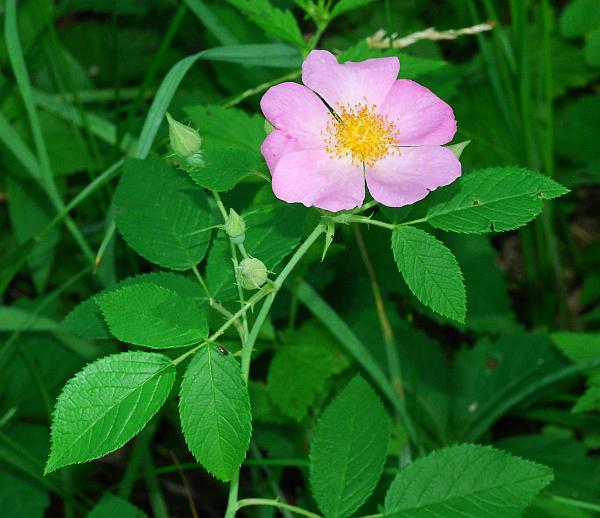Rosa setigera Michx.
Climbing Rose

Native
CC = 4
CW = 3
MOC = 86
© SRTurner
Rosa setigera Michx.Climbing Rose | |
 |
Native CC = 4 CW = 3 MOC = 86 |
© SRTurner |
|
Family - Rosaceae Habit - Shrub. Stems - Trailing or more commonly climbing on and through other vegetation, occasionally loosely twining, to 2 m, the tips often arched downward and occasionally rooting, usually relatively slender, green to light brown, glabrous or occasionally finely hairy, the prickles paired at the nodes and individual between the nodes, 5-9 mm long, 3-5 mm wide, broadened at the base, curved or occasionally some of them straight, stout, flattened, rarely unarmed.
Leaves - Alternate, pinnately compound, 8-12 cm long, the petiole and rachis usually finely hairy and with stalked glands, occasionally glabrous, sometimes also with small prickles. Stipules 12-15 mm long, the margins entire, but sparsely stalked-glandular, sometimes somewhat curved under, the auricle flared, 3-4 mm long. Leaflets 3 or 5, 30-50 mm long, 15-40 mm wide, the terminal leaflet with a stalk 10-16 mm long, the blade ovate to elliptic-ovate, broadly angled or rounded at the base, angled or more commonly tapered to a sharply pointed tip, the margins simply or doubly toothed with 18-42 teeth per side, these relatively coarse, gland-tipped, the upper surface glossy, green to dark green, usually glabrous, the undersurface lighter green, glabrous or finely hairy, sometimes also glandular.
Inflorescences - On lateral branches from second year's stems and axillary toward tips of current year's growth, of solitary flowers or more commonly more or less flat-topped clusters or small panicles of 3-6 flowers, the flower stalks 15-25 mm long, with stalked glands but usually lacking prickles, with 1 to several bracts, these slender, often shed early.
Flowers - Fragrant. Hypanthium 4-6 mm long, with usually dense stalked glands, the mouth 0.5-1.0 mm in diameter. Sepals 10-18 mm long, 2-4 mm wide, all similar, the margins entire, the undersurface finely woolly and stalked-glandular, becoming reflexed and shed soon after flowering. Petals 5, 18-25 mm long, pink to reddish pink, rarely white. Stamens numerous. Pistils 20-25, the styles fused, glabrous, extending 5-6 mm beyond the mouth of the hypanthium, thus protruding noticeably.
Fruits - Hips 6-10 mm long, 6-9 mm wide, globose to subglobose, more or less fleshy, the surface red, glabrous or with scattered stalked glands. Achenes 17-22, 4-5 mm long. Flowering - May - July. Habitat - Bottomland and mesic forests, streambanks, pond margins, upland prairies, glades, bluffs, edges of fens, pastures, fields, fencerows, ditches, railroads, and roadsides. Origin - Native to the U.S. Lookalikes - Other species of Rosa. Other info. - This is one of the more common roses found in Missouri, occurring nearly statewide, though uncommon in portions of the northwestern quadrant. Although there are several lookalikes, this species can be relatively easily identified by the combination of 3-5 leaflets per leaf and a stylar column which projects from the center of the flower. The infamous multiflora rose also has a stylar column, but that plant also has more numerous leaflets per leaf as well as fringed stipules. Numerous infraspecific forms have been described. The plant seems to prefer a shaded location with neighboring vegetation for support, but will also grow well alone and in the open. Photographs taken at the Robert E. Talbot Conservation Area, Lawrence County, MO., 7-4-03, and at Alley Spring, MO., 6-12-04 (DETenaglia); also at Onondaga Cave State Park, Crawford County, MO, 5-28-2012, Daniel Boone Conservation Area, Warren County, MO, 6-25-2013, Tingler Prairie Natural Area, Howell County, MO, 6-3-2017, and Chloe Lowry Marsh Natural Area, Mercer County, MO, 6-17-2018 (SRTurner). |